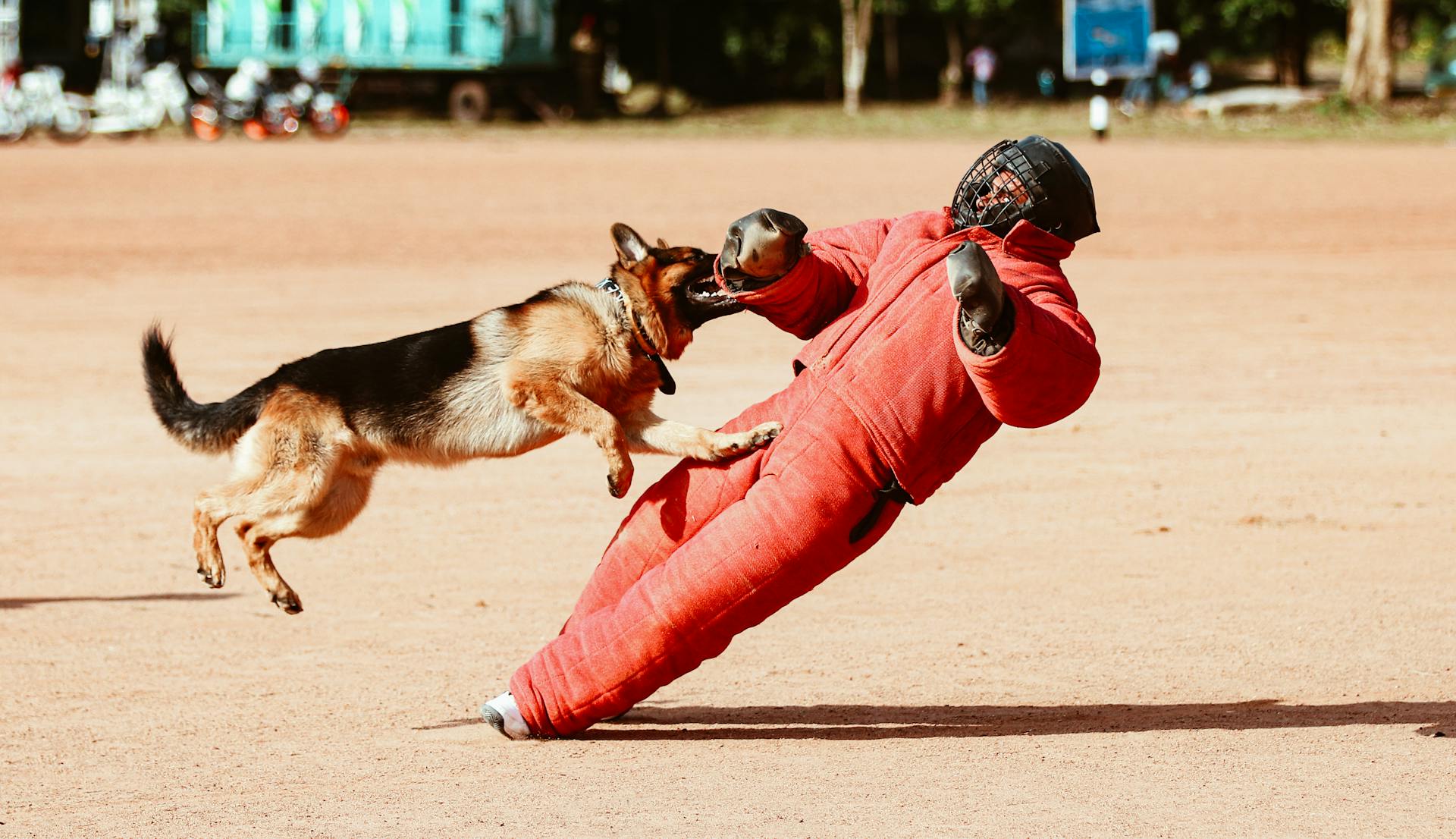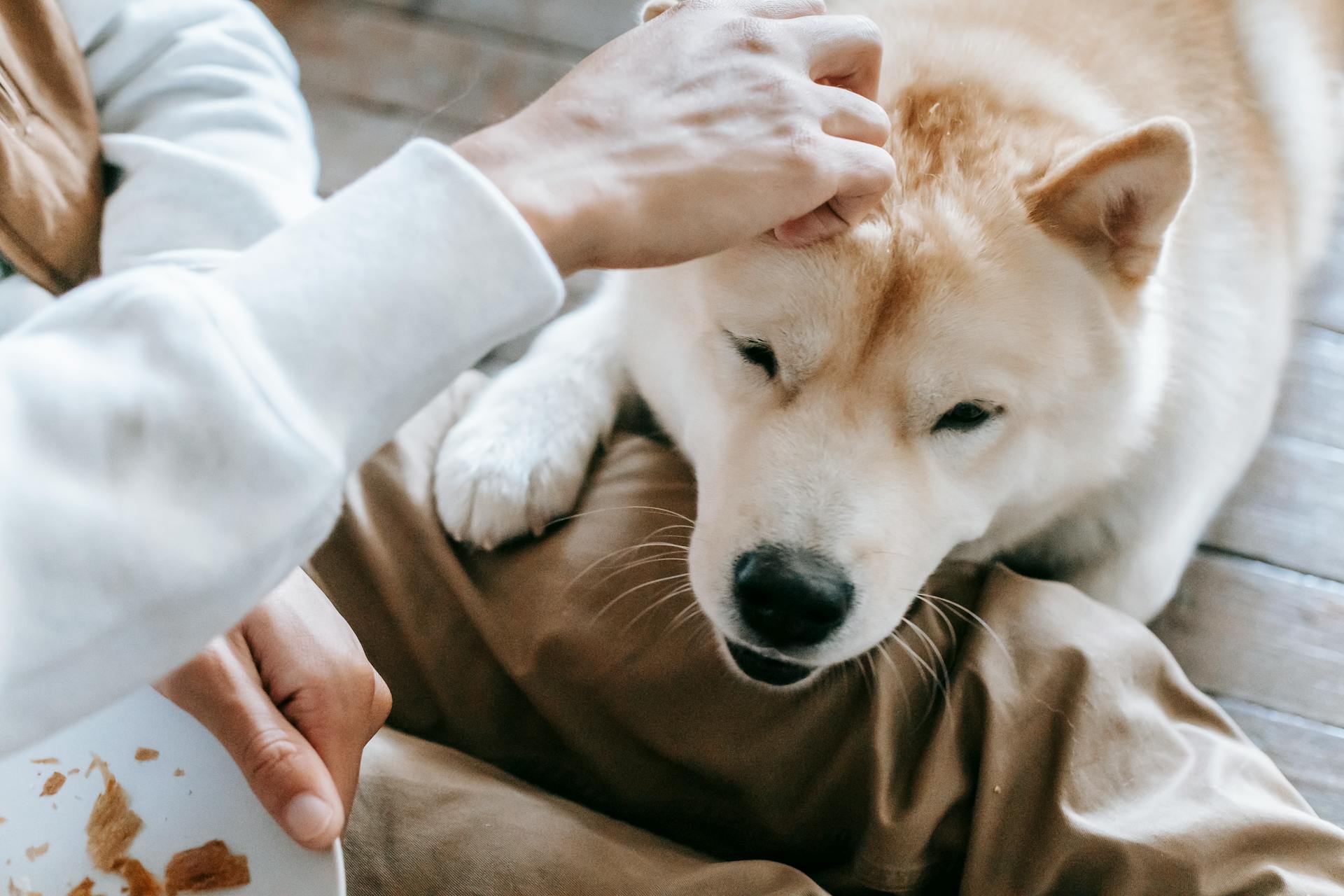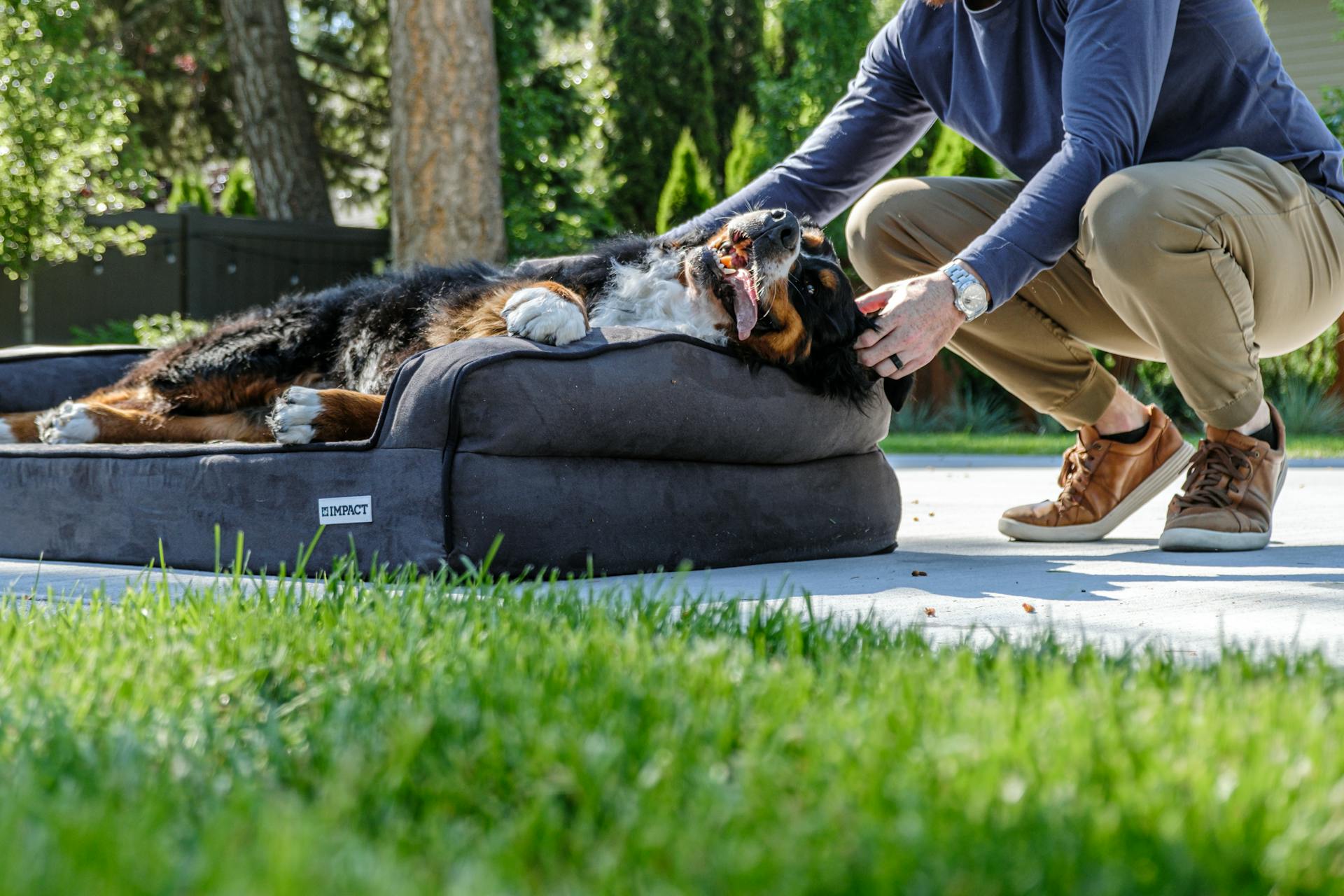
Dogs become aggressive and attack other dogs due to a combination of factors, including genetics, socialization, and environment.
Some dogs are naturally more aggressive due to their breed or lineage. For example, certain breeds like Pit Bulls and Rottweilers have been bred for fighting and may be more prone to aggression.
Poor socialization in early puppyhood can also contribute to aggression in dogs. Puppies that don't receive proper socialization may grow up to be fearful or aggressive around other dogs.
A dog's environment can also trigger aggression, especially if it's exposed to stressors like loud noises or other aggressive dogs.
Causes of Dog Attacks
Dogs may become overly aggressive due to past experiences, such as abuse and neglect. This can lead to a lack of socialization with other dogs, making them more likely to exhibit inter-dog aggression.
A traumatic encounter with another dog can also contribute to a dog's aggression. For instance, a dog that's been rescued from a dog fighting operation often shows more aggression towards other dogs.
An owner's behavior can influence a dog's aggression, such as punishing a dominant dog for showing compassion to a weaker one. This can create a power imbalance and lead to more aggression.
Fear is another reason dogs may attack other dogs. A dog may feel threatened or defensive, leading it to lash out at another dog.
Factors Contributing to Dog Aggression
Dogs may attack other dogs due to various factors, including their past experiences and emotions. A common cause of dog fights is resource fighting, where a dog tries to protect its resources, such as food, water, shelter, or toys.
Some dogs may be more prone to resource fighting due to past abuse or neglect. For example, a dog that was once abused or went without food may become aggressive when defending its resources. If a dog is anxious or afraid, it may also lash out at other dogs, even if they appear friendly.
On a similar theme: Resource Guarding People
Dogs are highly attuned to their owner's emotions and can pick up on anxiety or fear. If you're in public and another dog approaches, your dog may feel uncertain or fearful, leading it to attack the other dog. Staying calm can help your dog stay calm too.
Traumatic experiences, such as being attacked by another dog, can also cause a dog to become aggressive towards other dogs. This is because the dog may associate other dogs with the traumatic experience. Healing traumatic responses can be difficult, but it's not impossible with the help of a professional trainer and veterinary advice.
A fresh viewpoint: Does Cbd Help with Dog Aggression
Fighting Over Resources
Fighting Over Resources can be a common cause of dog aggression. This behavior is often seen in dogs that are trying to protect their resources, which can include food, water, shelter, or toys.
Some dogs are more prone to resource fighting than others, especially if they have a history of abuse or neglect. If a dog was once left without food, it may become overly protective of its resources.
Dogs that are resource guarders may exhibit aggressive behavior when they feel their resources are being threatened. This can include growling, snapping, or even attacking other dogs.
It's essential to recognize the signs of resource guarding in your dog, such as possessiveness over food or toys. If you notice your dog becoming overly protective of its resources, it's crucial to intervene and teach it to share calmly.
A fresh viewpoint: How to Break Resource Guarding
Other Reasons
Pain can be a significant contributor to dog aggression, as it can cause irritability and discomfort. This can lead to snapping or growling at other dogs.
Fear is another common reason for dog aggression, as dogs may become protective of themselves or their owners in fearful situations. For example, if a dog is anxious or afraid in public, it may lash out at another dog even if that dog appears friendly.
Dogs may also exhibit aggression due to dominance or territorial issues, especially if they perceive another dog as a threat to their position or resources. This can be triggered by a bad experience at a dog park or other social situation.
Old age can also be a factor, although it's not the case in this particular situation. However, it's essential to consider other possibilities, such as illness or pain, when trying to determine the cause of dog aggression.
In some cases, dogs may become aggressive due to redirected frustration, such as when they're unable to relieve themselves and take out their frustration on another dog. This highlights the importance of providing regular potty breaks and exercise to prevent such situations.
Traumatic experiences, such as being attacked by a dog or living on the street, can also lead to dog aggression, especially if the dog is fearful or has developed a survival mode. In such cases, healing traumatic responses can be challenging but is not impossible with professional guidance and training.
Worth a look: Why Do Dogs Attack When They Sense Fear
Addressing Dog Aggression
Addressing dog aggression is crucial to prevent harm to both dogs and their owners. It's essential to correct the problem as early as possible.
If your adult dog shows signs of aggression, you may want to use a professional to help with socializing. You can also start a regular, daily training regiment with basic control commands like sit, heel, and walk on a leash.
Regular exercise is also vital to reduce aggression in dogs. Consider using a professional dog walker or family members to give your dog exercise during the day if you work. Play with it often and give it ample time to get out any pent-up energy.
To prevent aggression in puppies, enroll in a puppy training program that teaches good manners, positive behaviors, and basic commands. Socialize your puppy often by taking it to the dog park, vet, or doggy daycare programs.
Roughhousing with your pup can teach negative behaviors, so avoid it altogether. Never use hitting as a punishment, as it can teach your dog only fear and may react aggressively as it gets older.
If your dog attacks another dog unprovoked, staying calm is crucial. Avoid physical contact, as it can result in serious injuries. Instead, distract your dog with a loud noise, such as clapping your hands or shouting, to break their focus on each other.
Consider reading: How Often Do Dogs Attack Their Owners
If you discover that your dog is prone to attacking other dogs unprovoked, work with your vet to rule out any medical reasons for the sudden aggression. Then, work with an accredited dog trainer to help your dog become more calm in social situations.
Here are some steps to take if your dog attacks another dog:
- Stay calm and avoid physical contact.
- Distract your dog with a loud noise, such as clapping your hands or shouting.
- Create a barrier, if possible, to separate the dogs.
- Remove your dog from the area with a lead or slip lead and check for any injuries.
Remember, addressing dog aggression requires patience, consistency, and professional help when needed.
Handling Dog Aggression
Handling dog aggression requires patience and a consistent plan. Dealing with a dog that shows aggression toward other dogs can be challenging, but it's essential to address the issue.
It's crucial to avoid situations that encourage aggressive behavior in the dog. This means taking steps to prevent interactions with other dogs, especially in areas where conflicts are more likely to occur.
Controlling the problem is the primary focus of treatment. There is no real cure for inter-dog aggression, so owners must learn how to manage the situation.
Breaking up fights quickly and safely is critical when they do occur. This involves intervening promptly and using the right equipment, such as a protective head halter and basket muzzle.
Keeping the dog under constant control is vital, especially in situations where aggressive behavior is more likely. This may mean keeping the dog on a short leash or in a secure area.
Training the dog to feel comfortable wearing a protective head halter and basket muzzle can be an effective way to reduce the risk of injury. This training should be done carefully and consistently.
Here's an interesting read: All about Dogs Dog Training
Understanding Dog Behavior
Dogs rely heavily on social cues to communicate, using sounds, body posture, tails, and ears to convey their emotions. If a dog misinterprets a friendly dog as aggressive, it may lash out from fear or protectiveness.
Having multiple dogs can actually help them learn about social cues, but an only dog may struggle to pick up on these cues, especially if it wasn't socialized properly. Socialization is key to preventing aggression in dogs.
A dog that wasn't socialized as a puppy may be more likely to misinterpret social cues and become aggressive, but it's never too late to start teaching your dog social skills. Taking your dog to a dog park, on frequent walks, and to play dates with other pet owners can help.
Something Is Ill
If your dog is displaying aggression, it's possible that something is physically or medically ailing them. This can be especially common in older dogs with conditions such as hip dysplasia or arthritis.
Dogs with physical issues may not appreciate the rough play of younger pups, leading to aggression. Any time your dog shows sudden-onset aggression, a veterinary checkup is in order.
A veterinary checkup can help identify underlying medical issues that may be contributing to your dog's aggression. This is especially important if your dog is showing aggression towards other dogs.
Here are some common medical issues that can lead to dog aggression:
- Hip dysplasia
- Arthritis
- Other age-related health issues
By addressing any underlying medical issues, you can help reduce your dog's aggression and improve their overall well-being.
Trauma Responses
Trauma can have a lasting impact on a dog's behavior. A dog that's been attacked by another dog may become aggressive towards other dogs in the future.
Traumatic experiences can include being abused, living on the street, or being attacked by another dog. This can cause a dog to become fearful and defensive.
A traumatic experience at the park, such as being attacked by another dog, can change a dog's behavior. Your dog may become aggressive towards other dogs at the park, thinking they mean harm.
Healing traumatic responses can be difficult, but it's not impossible. You'll want to work with a professional trainer and follow veterinary advice.
A dog that's had a traumatic experience may not always show obvious signs of fear or aggression. However, their behavior may change in subtle ways, such as becoming more protective or defensive.
Broaden your view: My Dog Was Attacked by a Pitbull
Symptoms and Types
Symptoms of inter-dog aggression can be subtle, but they're worth recognizing to prevent severe incidents. Growling, biting, lip lifting, snapping, and lunging toward another dog are all common symptoms.
Before an aggressive incident occurs, dogs may exhibit more discreet signs of social control, such as staring and blocking their companion's entrance into a room.
A fearful or submissive body posture can be a sign of underlying aggression, often accompanied by expressions like crouching, tucking the tail under, licking the lips, and backing away.
A specific condition or trigger can sometimes set off aggression in dogs that normally get along well.
Frequently Asked Questions
Should a dog be put down for attacking other dogs?
Deciding to put a dog down for aggression towards other dogs should be a carefully considered decision, not made in the heat of the moment. Consider seeking professional help and exploring alternatives before making a decision
How do I stop my dog from attacking other dogs?
Stop dog aggression by learning your dog's language, identifying and avoiding stressors, and working with a qualified professional to implement counter-conditioning and desensitization techniques
Sources
- https://thedogwizard.com/blog/dogs-attack-other-dogs-that-are-friendly/
- https://holidaybarn.com/blog/unprovoked-aggression-in-dogs/
- https://sidneyaarons.com.au/2018/08/13/my-dog-is-aggressive-towards-other-dogs-why-is-it-so-and-what-can-i-do-about-it/
- https://www.petmd.com/dog/conditions/behavioral/c_dg_AggressionInterdog
- https://dogtime.com/dog-health/dog-behavior/5133-dog-suddenly-aggressive-toward-dogs-wild-faq
Featured Images: pexels.com


